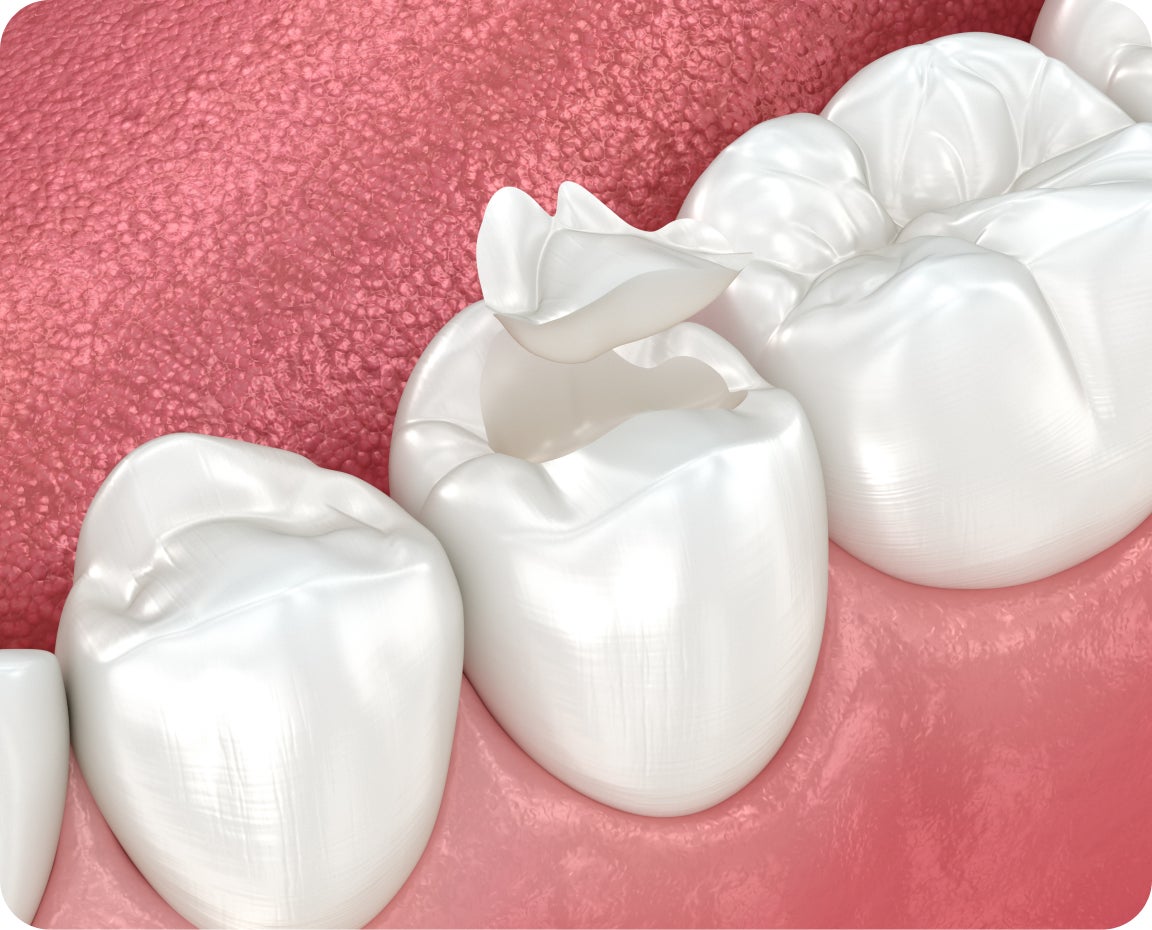Last updated 08.11.2025
Temporary tooth filling: all you need to know
This article explains temporary tooth fillings and the materials, procedure, and care while awaiting a permanent fix.

Filling cavities is a straightforward and quick process. At Aspen Dental, we offer both temporary and permanent fillings, depending on your needs. Permanent fillings provide long-term protection, while temporary fillings are a short-term solution, lasting a few weeks to a few months, until it’s time for your permanent solution.
Don’t wait until it becomes an emergency—take the first step towards relief today. Schedule an appointment with your Aspen Dental care team to get started.
What are temporary tooth fillings?
A temporary tooth filling is a short-term solution designed to protect a damaged or decayed tooth until a permanent fix is ready. These fillings are often used after a root canal or while waiting for a crown. They help shield you teeth from bacteria, reduce sensitivity and let you return to your daily life without worry. While they’re not meant to last forever, they do their job well enough to keep your oral health on track until your permanent restoration is in place.

Temporary tooth filling vs. permanent filling
While both types of fillings protect your teeth, they’re designed for different purposes. Here’s a quick breakdown of how they compare:
Purpose: Temporary fillings are a short-term fix, often used while waiting for a permanent solution or to allow healing after a root canal. Permanent fillings, on the other hand, are built to protect your teeth for the long haul.
Materials: Temporary fillings are made from softer, more affordable materials like glass ionomer, making them easy to apply. Permanent fillings use stronger materials like composite resin or amalgam for long-lasting protection.
Longevity: Temporary fillings are designed to last a few weeks to a couple of months, while permanent fillings can last up to 15 years or even longer with proper care.1
Strength and durability: While temporary fillings are sturdy enough to get you through a few months, they’re not as strong as permanent fillings, which are built to handle daily biting and chewing.
Placement: Temporary fillings are quicker and easier to apply, while permanent fillings take a bit more work, but are still relatively simple compared to advanced dental treatments.
1Source: Healthline - How Long Do Fillings Last?
What are temporary tooth fillings made of?
Temporary fillings are made from a variety of materials, and your dentist will choose the one that suits your needs best. Here’s a quick rundown:
Zinc oxide eugenol: Combines zinc oxide’s antibacterial powers with eugenol, a clove-based material that helps with pain relief and inflammation.
Zinc phosphate cement: This is commonly used to cement a temporary crown to a tooth. It is not used as a filling material itself.
Glass ionomer: Releases fluoride to strengthen your enamel and stop further decay.
Cavit: Self-hardens without needing a bonding compound and is easy to remove when it’s time for the permanent filling.

When temporary tooth fillings are used
Dentists use temporary fillings in many cases to protect and support your teeth while waiting for a more permanent fix. Here are some common situations:
Dental crowns
Crowns are a great way to repair damaged or decayed teeth, restoring their look and function. But since crowns take a little time to make, a temporary filling is placed in the meantime. This helps protect your tooth from infection, keeps its shape and prevents further damage or decay until the crown is ready.
Root canals
After a root canal, where the damaged or infected pulp is removed from inside your tooth, the area needs to be sealed to stay protected and strong. A temporary filling is used to keep everything safe until your permanent restoration, like a crown, is ready to go. Sometimes, the procedure may take multiple visits, and temporary fillings are used for ease of re-access to complete the procedure after healing times or follow-up visits.
Sensitive nerves
Sometimes tooth decay or certain dental work can expose sensitive parts of your tooth, making eating, drinking or even speaking uncomfortable. A temporary filling helps protect the area, reduces sensitivity and stops further damage while your dentist at Aspen Dental assesses the best course of action.
The temporary filling procedure
Getting a temporary filling at Aspen Dental? Here’s what you can expect during your visit:
Pain management: Your dentist will numb the area to keep you comfortable throughout the procedure.
Cleaning: They’ll clean out any debris from the tooth, including plaque, old filling materials and any decayed areas, unless a root canal is needed, which will require a root canal procedure.
Filling application: Next, they’ll apply the filling material to the decayed area. It starts off soft so it can be shaped just right.
Shaping: While the material is still soft, your dentist will shape it to match your tooth’s shape and bite.
Hardening: The filling will either harden on its own (if it’s self-hardening, like Cavit) or your dentist will use a special curing light to set it in place.
Adjusting: Finally, they’ll smooth out any rough edges and make sure it feels comfortable.
Aftercare: Before you leave, your dentist will share tips on how to care for your filling, including any diet adjustments. They’ll also let you know when to come back for the permanent fix.
Temporary tooth filling FAQs
How long does a temporary tooth filling last?
Temporary fillings usually last a few weeks to a few months, depending on the material and how you care for them. They’re not meant to last forever, but with good care, they’ll protect your tooth until your permanent restoration is ready.
Can I eat food on my temporary filling?
Yes, you can. Just remember to be cautious when eating. Chewing too hard or biting down on tough foods can loosen, damage the filling or even fracture the tooth. Stick to soft or liquid foods and try to avoid chewing on the side of your mouth with the filling. It’s always better to play it safe and always follow your dentist’s instructions.
What are the benefits of temporary fillings?
Temporary fillings do a great job of protecting your tooth from further damage, decay or infection. They help maintain the structure and strength of your tooth and also stop sensitivity by shielding the inner nerves and tissue. In short, they keep your tooth healthy and safe while you wait for your permanent filling or restoration.

Learn more about temporary tooth fillings at Aspen Dental
Temporary fillings are an easy way to protect your teeth from damage and decay while you wait for the permanent fix. They’re quick and simple, making them great for root canal aftercare, permanent crowns or emergency procedures.
If you think you might have a cavity, don’t wait—little issues can turn into big problems fast. Schedule an appointment with Aspen Dental today. Your care team is here to help you get back to smiling with confidence.



